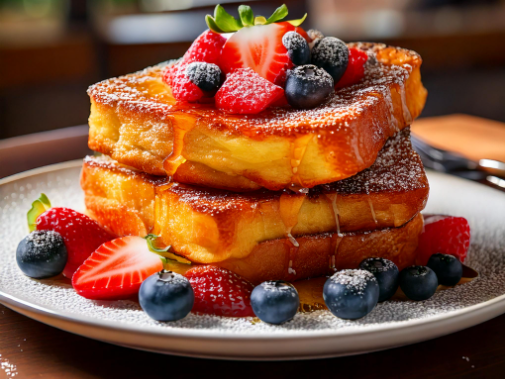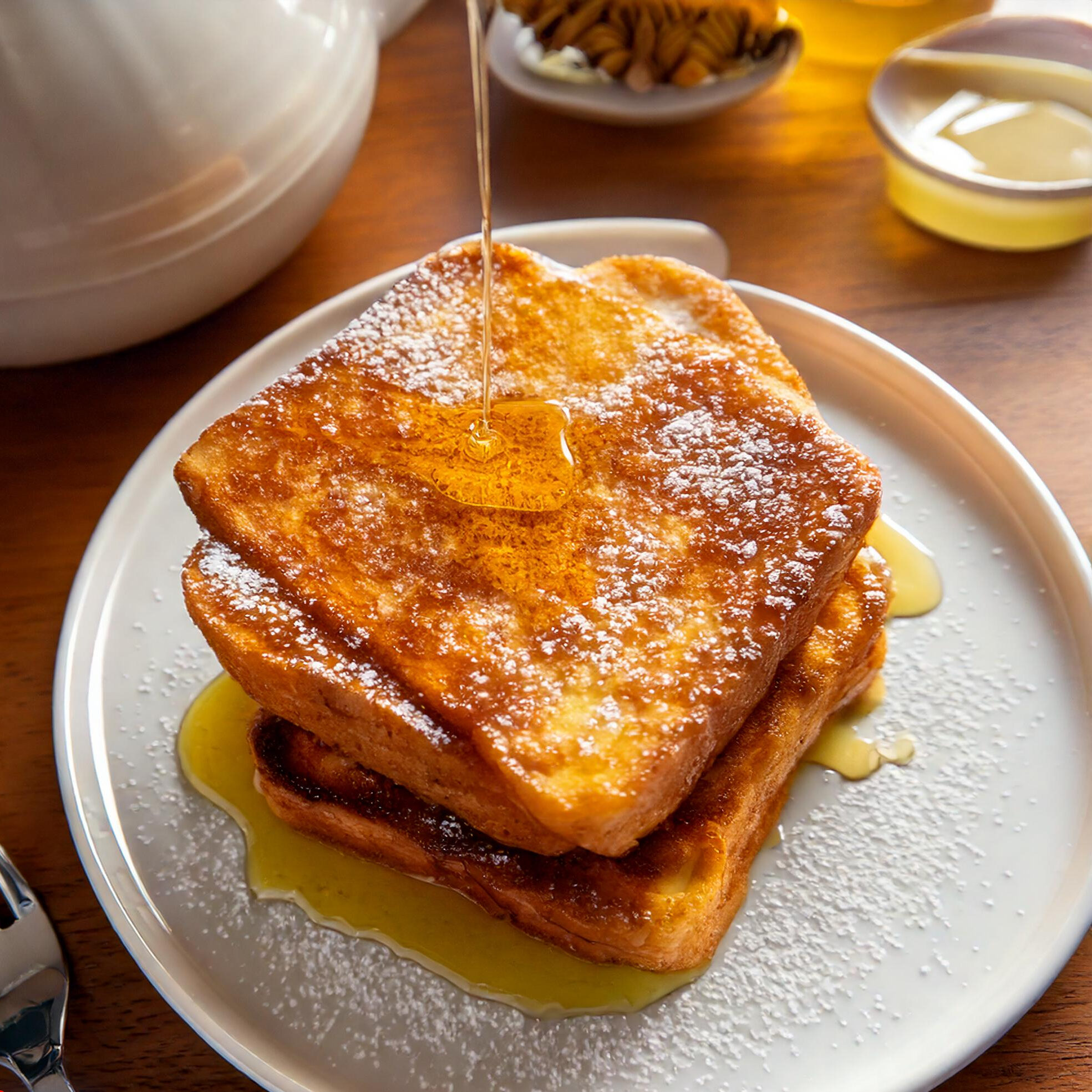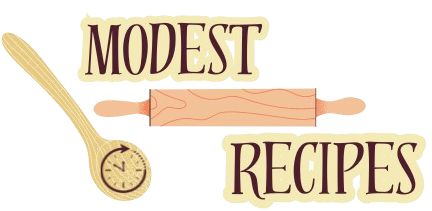
French Toast
French toast is a beloved classic—simple, satisfying, and a dish that everyone can master. With just a few budget-friendly ingredients and a touch of technique, this recipe transforms humble bread into a luxurious breakfast. It’s ideal for modest cooking, keeping things simple yet flavorful. Let’s dive into the perfect French toast recipe, step-by-step, so you can start your day off right with this warm, comforting breakfast.
Recipe Card
Description: French toast is a rich, golden-brown treat that’s crispy on the outside and soft on the inside, ideal for breakfast, brunch, or even dessert.
- Prep Time: 10 minutes
- Cook Time: 15 minutes
- Total Time: 25 minutes
- Servings: 4
- Calories: 320 per serving
Ingredients
- 4 slices thick bread (preferably brioche or challah)
- 2 large eggs
- ½ cup milk (use whole milk for creaminess or almond milk for dairy-free)
- 1 teaspoon vanilla extract
- ½ teaspoon ground cinnamon
- 1 tablespoon granulated sugar (optional)
- ¼ teaspoon salt
- Butter or oil for cooking
- Optional toppings: maple syrup, powdered sugar, fresh berries, whipped cream
Nutrition Information (per serving):
- Calories: 320
- Carbs: 35g
- Protein: 10g
- Fat: 15g
Why You’ll Love This Recipe
- Budget-Friendly: French toast uses basic ingredients you likely already have on hand, making it a cost-effective choice.
- Easy to Customize: Add brown sugar, substitute dairy-free milk, or experiment with toppings.
- Perfect for Beginners: With simple steps and common ingredients, this recipe is ideal for those new to cooking and baking.
- Quick and Satisfying: From start to finish, you can enjoy French toast in less than 30 minutes.
- Modest and Versatile: Perfect for any occasion, from a simple breakfast to a cozy brunch with friends.
Key Ingredients and Substitutions
Bread: The heart of French toast, ideally thick and slightly stale. Brioche or challah are excellent choices for their rich texture, but whole-grain or sourdough can add a rustic flavor.
Eggs: Essential for creating the custard-like coating, giving French toast its structure and richness.
Milk: Whole milk gives creaminess, but almond or oat milk works well for a dairy-free version.
Cinnamon and Vanilla: These add warmth and aroma, enhancing the flavor of each bite.
Sugar: Optional, but a small amount of sugar in the batter adds sweetness. Can you add brown sugar? Absolutely! Brown sugar brings a caramel-like depth of flavor to the mix, perfect for a richer taste.

How to Make French Toast: Step-by-Step Guide
- Whisk the Batter: In a mixing bowl, combine eggs, milk, cinnamon, vanilla, sugar, and salt. Whisk until smooth, with no visible streaks of egg.
- Soak the Bread: Dip one slice of bread into the egg mixture, making sure it’s thoroughly coated. Let it sit for a few seconds, but avoid over-soaking to prevent sogginess.
- Heat the Skillet: Place a non-stick skillet over medium heat and add a pat of butter or a splash of oil. it to melt, coating the pan evenly.
- Cook the Toast: Add the soaked bread to the pan and cook for 3-4 minutes on each side, or until each side is golden brown. Adjust the heat as necessary to avoid burning.
- Serve Hot: Plate the French toast and top with syrup, fresh fruit, powdered sugar, or any toppings you love.
Expert Tips for Success
Use Stale Bread: Slightly dry bread absorbs the batter without becoming too soggy. If your bread is fresh, try toasting it lightly before dipping.
Perfect Heat Control: Medium heat ensures an even, golden crust without burning.
Avoid Over-Soaking: Give each slice just enough time to absorb the batter without becoming overly saturated.
Adjust Sugar and Spices: Tailor the batter to your taste by adding more or less cinnamon or substituting white sugar with brown sugar for extra richness.
Variations and Customizations
Stuffed French Toast: Try adding a layer of cream cheese or Nutella between two slices before dipping in the batter for an extra indulgent treat.
Savory Twist: Skip the vanilla and cinnamon and add a pinch of salt and pepper instead. Serve with avocado or smoked salmon for a unique twist.
Cinnamon Raisin French Toast: Use cinnamon raisin bread and sprinkle extra cinnamon in the batter for a flavorful breakfast.
Banana Foster French Toast: Top with caramelized bananas and a drizzle of caramel sauce for a dessert-inspired breakfast.
Storage and Reheating Instructions
To Store: Place leftover French toast in an airtight container and refrigerate for up to 3 days.
To Freeze: Lay slices on a baking sheet and freeze until solid, then transfer to a freezer-safe bag for up to 1 month.
To Reheat: Warm in a toaster or oven at 350°F (175°C) for about 5 minutes to regain crispness.
Serving Suggestions
French toast is versatile, pairing well with various toppings and sides. For a classic breakfast, serve with fresh berries, a dollop of whipped cream, and a drizzle of maple syrup. For a brunch spread, pair French toast with bacon, scrambled eggs, and a side of fresh orange juice or coffee.
FAQs
1. Can you use any bread for French toast?
Yes, but thicker, slightly stale bread like brioche or challah works best. It holds up better and absorbs the batter evenly.
2. Can you add brown sugar to the recipe?
Definitely! Brown sugar adds a deeper, caramel-like flavor to the batter. Replace the white sugar with brown if you prefer a richer taste.
3. How do I keep French toast from getting soggy?
Use stale bread and don’t over-soak. Also, cook on medium heat to ensure a golden, crispy outside without sogginess.
4. Can French toast be made dairy-free?
Yes! Substitute whole milk with almond, oat, or soy milk for a dairy-free version that’s just as creamy.
Related Recipes
If you loved this French toast recipe, you might also enjoy these modest, budget-friendly breakfast options:
Banana Pancakes: A simple, flourless pancake made with bananas and eggs.
Avocado Toast with Poached Egg: Creamy avocado with a runny poached egg on whole-grain toast.
Blueberry Overnight Oats: A quick and nutritious make-ahead breakfast loaded with fiber.
Conclusion
French toast is a timeless breakfast staple, modest yet deliciously satisfying. With this recipe, you’ll master the basics of making perfect French toast every time. Remember, it’s all about finding the right bread, balancing the flavors, and cooking with care. Whether it’s for a quick breakfast, weekend brunch, or special occasion, French toast is guaranteed to impress.
So, why not treat yourself or your loved ones to a cozy, homemade breakfast? Grab your favorite bread, a dash of cinnamon, and get cooking!

